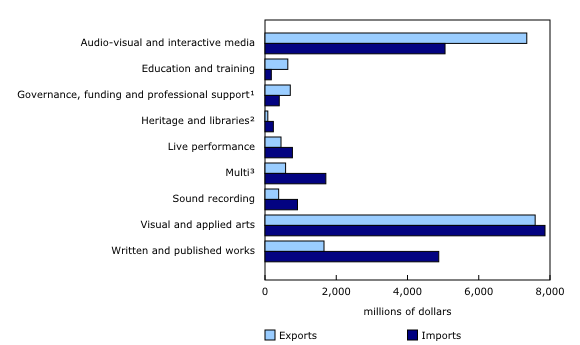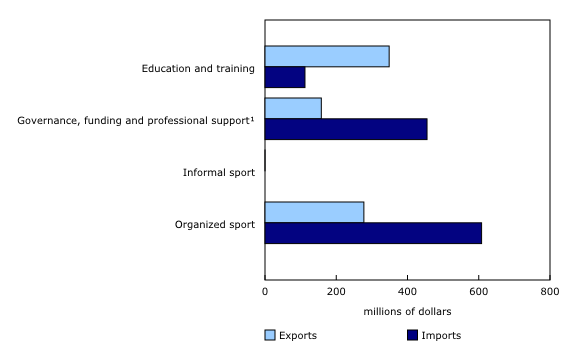Trade of culture and sport products, 2020
Released: 2022-10-04
Exports of culture and sport products dropped 8.9% from 2019 to $20.2 billion in 2020, representing 3.1% of Canada's total exports. During that same period, imports declined 12.8% to $23.2 billion, representing 3.3% of total imports.
The year 2020 marked some of the largest decreases in Canadian trade in decades, as many countries, including Canada, closed their borders in an effort to control the spread of COVID-19, with total exports (-13.0%) and imports (-11.3%) decreasing.
The gap between exports and imports of culture and sport products has been steadily narrowing since 2010. In 2010, just over two-fifths (40.9%) of trade was in exports, compared with 46.6% in 2020. Historically speaking, we import more culture and sport products than we export, resulting in a trade deficit.
International trade of culture products fared better than expected in 2020
Although total trade was down for culture and sport products, due in part to a substantial drop in the exports of sport products, on the whole, culture products fared better than expected. Canada exported $19.4 billion of culture products in 2020, down 4.4% from the previous year. Increased exports of interactive media, crafts and advertising products helped to stem the often-large declines in many other areas in 2020. Canada's growing software development and computer services sectors contributed to increased exports of services such as computer system design services and video game design. Crafts—primarily jewellery and silverware—also accounted for over $4.2 billion in culture exports. However, these areas of growth were outweighed by large declines in the live performance, governance, funding and professional support, and written and public works domains.
Culture imports declined 7.6% to $22.0 billion, led mainly by decreases in visual and applied arts, and live performance. This was partially offset by increases in audio-visual and interactive media and culture education and training.
Trade of sport products hit hard by the COVID-19 pandemic
Canada exported $0.8 billion of sport products and imported $1.2 billion in 2020, with exports and imports decreasing by more than 50% from 2019. The year 2020 marked the largest trade decreases on record, with sizeable declines in the organized sport and governance, funding and professional support subdomains.
The United States and European Union continue to be Canada's top two trading partners of culture and sport products
Exports to the United States represented 66.0% of Canada's total exports of culture and sport products in 2020. Meanwhile, the share of Canada's imports of culture and sport products from the United States was 64.2% in 2020. The United States continues to be Canada's largest trading partner for culture and sport products. With the United States being our closest trading partner, coupled with the fact we share a border, it is not surprising that trade between the two nations remained strong amidst the pandemic.
The European Union ranked a distant second, accounting for 10.7% of exports and 10.1% of imports. Combined, the United States and European Union accounted for close to 80% of Canada's trade of culture and sport products. The most heavily exported products by Canada were in the visual and applied arts and audio-visual and interactive media domains. On the import side, it was visual and applied arts, and written and published works, followed by audio-visual and interactive media.
Interprovincial trade of culture and sport in 2018
Trade among the provinces and territories has always been pivotal to the Canadian economy. In 2018, interprovincial trade in culture products amounted to $20.1 billion. Interprovincial trade (exports and imports) of culture and sport estimates are available only up to 2018. The audio-visual and interactive media domain continues to be the largest contributor to interprovincial trade, particularly in the interactive media and broadcasting subdomain.
Interprovincial trade of sport products totalled $1.4 billion in 2018. Governance, funding and professional support (which includes public sport facilities and rentals) and organized sport led interprovincial trade of sport products.
Note to readers
The Trade of Culture and Sport Products (TCSP) provides measures of the international and interprovincial trade of goods and services attributed to both culture and sport (inclusive of the arts and heritage).
These data were developed as an extension of the Canadian Culture Satellite Account and the Provincial and Territorial Culture Satellite Indicators by providing additional information about the state of culture and sport for Canada, the provinces and territories.
The TCSP is a joint initiative of Statistics Canada, other federal agencies, all provincial and territorial governments, and non-governmental organizations.
All estimates of international trade are recorded or converted to Canadian dollars using daily or monthly average exchange rates.
Culture products are goods and services produced from creative artistic activity or from the preservation of heritage.
Sport products includes goods and services related to recreational sports and physical activities, and professional, semi-professional and amateur sport clubs and independent athletes that are primarily engaged in presenting sporting events before an audience. The classification excludes goods and services that are inputs for producing sport products such as equipment, but it includes merchandise sold at sporting events.
Due to data availability, interprovincial trade can only be derived up until 2018, as it is released at the same time as the published Supply Use Tables.
Crafts
The Crafts sub-domain includes various manufactured products that originate from creative artistic activities. It includes items such as jewellery, pottery, and knives. However, due to measurement limitations estimates of trade for the Crafts sub-domain may be overstated.
Film and video
The Film and video sub-domain has undergone major enhancements starting with reference year 2015. The sources and methods for estimating this sub-domain, including the Film, Television and Video Production Industry Survey, have been revised to incorporate improved estimation methods. The new methodology increases the use of administrative data in combination with survey data to build the estimates. These improvements were applied to all economic variables, including trade.
As a result, estimates for the Film and video sub-domain for 2015 onward should not be compared with historical estimates.
Users should exercise caution when using aggregate estimates that include the Film and video sub-domain such as estimates of the Audio-visual and interactive media domain and the total aggregate for culture. These aggregates will reflect the improvements to the methodology and, depending on the economic importance of the Film and video sub-domain, could be significantly impacted by the refinements.
Digital culture products
Technological advancements in recent years have improved the efficiency of delivery methods and consumption of services. However, this has created challenges in measuring international trade of digital services. This includes digital culture products, such as online streaming services, subscriptions, and downloads that are purchased by Canadian households directly from foreign suppliers.
Products
The Economic accounts statistics portal, accessible from the Subjects module of our website, features an up-to-date portrait of national and provincial economies and their structure.
The Latest Developments in the Canadian Economic Accounts (13-605-X) is available.
The User Guide: Canadian System of Macroeconomic Accounts (13-606-G) is available.
The Methodological Guide: Canadian System of Macroeconomic Accounts (13-607-X) is available.
Contact information
For more information, or to enquire about the concepts, methods or data quality of this release, contact us (toll-free 1-800-263-1136; 514-283-8300; infostats@statcan.gc.ca) or Media Relations (statcan.mediahotline-ligneinfomedias.statcan@statcan.gc.ca).
- Date modified:




